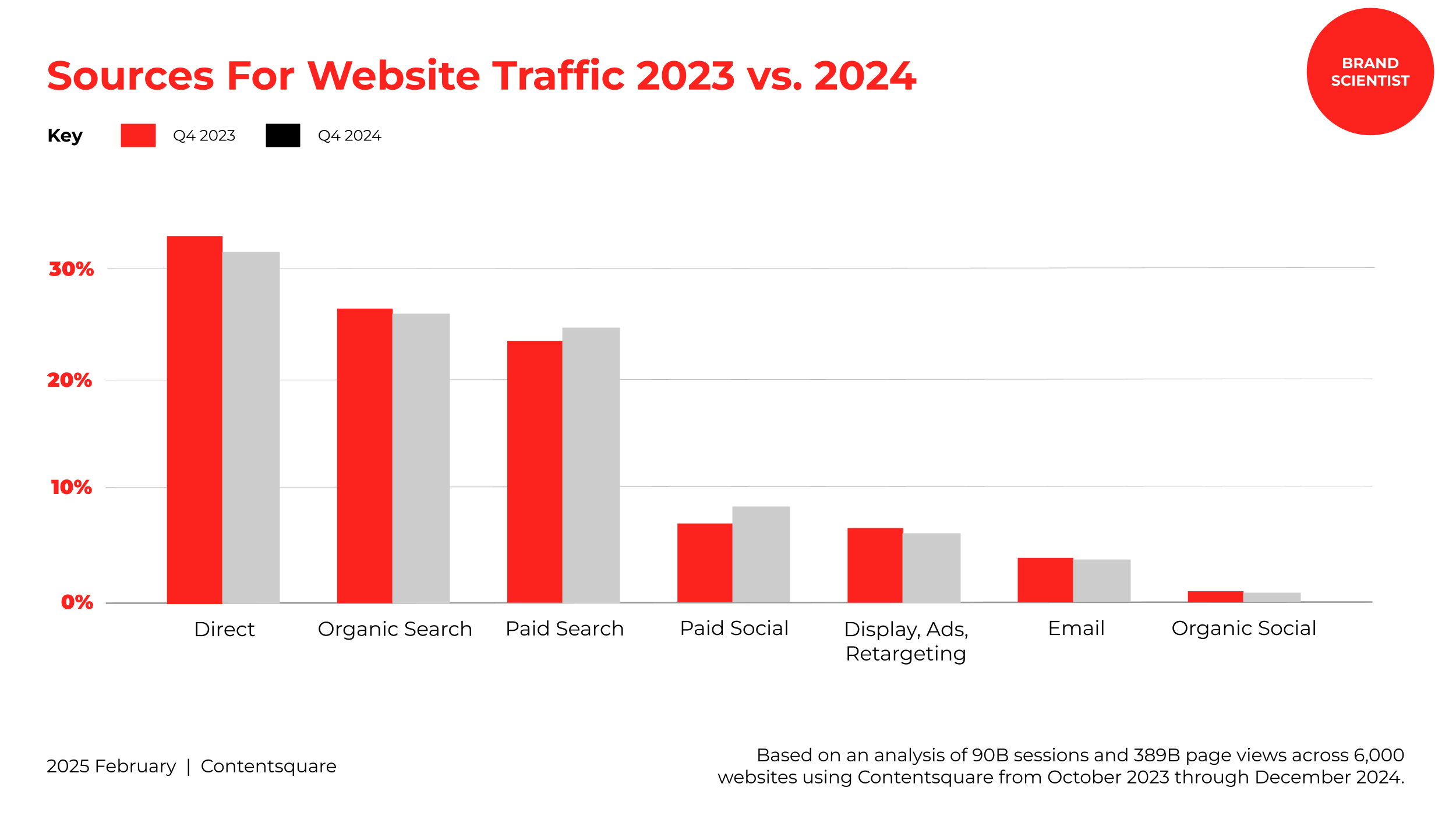Website Visitors Are Gaining In Expense
Getting visitors to a website is more expensive than ever, and once they arrive, they’re engaging less. According to the 2025 Digital Experience Benchmark Report from Contentsquare, key digital performance indicators (KPIs) worsened year-over-year in Q4 2024. Overall website traffic declined by 3.3%, content consumption dropped by 6.5%, and conversion rates fell by 6.1%. While visitor frustration slightly improved (40.1% of visits experienced friction, down by 2.1%), the cost per visit has grown by 19% over the past two years.
Paid traffic continues to gain a larger share, now making up 39% of all website visits (up from 37% the year prior) and driving 45% of new visitors. Paid social saw the most growth, increasing from 6.9% to 8.4% of total traffic. However, the data suggests that an increased reliance on paid social does not translate to better results. Websites with growing paid social traffic experienced higher bounce rates (+9.2%), fewer page views per session (-8.7%), and lower conversion rates (-10.6%), while those decreasing paid social saw modest improvements in engagement and conversions.
Beyond traffic sources, declining conversion rates are also linked to reduced content consumption. Sites where users visited more pages saw a 5.4% increase in conversion rates, whereas those with a 10% decrease in session depth suffered a 13.1% drop in conversions. Returning visitors proved significantly more engaged than new ones, browsing 19.5% more pages and spending an average of one minute longer on-site.
Friction remains a critical issue, with 40.1% of sessions being impacted by frustration factors such as slow page loads (15.2% of visits), JavaScript errors (18.8%), and excessive clicking behaviors (rage clicks and multiple button clicks). Addressing these technical issues is crucial to keeping users engaged and improving conversions. As website performance and user experience play an increasingly pivotal role in marketing success, brands must refine their strategies to reduce friction, improve engagement, and optimize paid traffic effectiveness.
Key Actionable Takeaways:
Optimize Paid Traffic ROI – Since paid visits are increasing but not always converting, refine ad targeting, messaging, and landing page experiences for better efficiency.
Improve Page Load Speed – With slow-loading pages frustrating 15.2% of users, optimize site performance to reduce bounce rates and retain visitors.
Focus on Retention Over Acquisition – Returning visitors engage more and convert at higher rates, so invest in email marketing, loyalty programs, and retargeting strategies.
Reduce Friction Points on the Site – Address common frustration signals like JavaScript errors, multiple clicks, and slow page speeds to improve user experience.
Enhance Content Depth to Boost Conversions – Sites where users visit more pages see higher conversion rates—encourage deeper engagement through better content navigation.
Reevaluate Paid Social Strategy – As paid social traffic grows but underperforms in conversions, test different platforms, creatives, and audience segments to maximize effectiveness.
Leverage First-Party Data for Better Targeting – With organic traffic declining, use customer data to refine ad targeting and personalize user experiences.
A/B Test Landing Pages – Test different landing page designs and calls-to-action to increase session depth and improve conversion rates.
Monitor Engagement Metrics Over Traffic Volume – Instead of chasing more visitors, focus on KPIs like time on site, pages per session, and returning visitor rates to drive better performance.
Align Content with User Intent – Ensure that landing pages and website content align with user expectations, making it easier for visitors to find what they need and take action.
